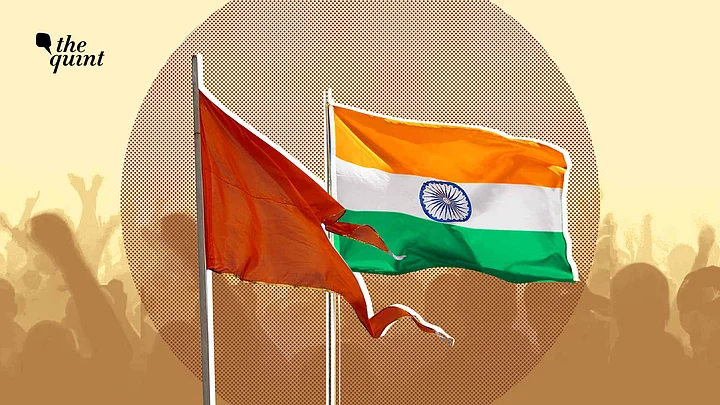Independence Day 2023 had seen an enthusiastic – albeit uncritical – Har Ghar Tiranga campaign to celebrate the Tricolour as 'national pride'. In sharp contrast, Republic Day 2024 saw the Bharatiya Janata Party (BJP) folk embroiled in the primacy of saffron over the Tricolour.
Even the saffron flag incident at Keragodu village in Mandya district of Karnataka points at the BJP's alleged ambivalence towards the National Flag.
This is a direct fallout of the organised party campaign marking the consecration of the Ram Temple in Ayodhya.
On one side, the party projects a plank of hypernationalism. On the other, numerous incidents of members lending pre-eminence to saffron are reported. Hoisting saffron flags on government properties, placing it above the National Flag, hoisting the National Flag on lotus flagpoles, etc., have occurred, and are in violation of the Prevention of Insults to National Honour Act.
Are such incidences of ambivalence due to their competing loyalties between the two flags, or is their uber-nationalist posturing really a cloak for Hindutva-first?
Saffron Flag: Now & Then
Party flags, colours, and symbols evoke cadre ownership and pride, and also create associations in voter memory. They also communicate party ideals and values.
To affect public psyche, mobilised political campaigns are carpet-bombed with party flags. However, BJP events are unique in this aspect. Beyond party flags, there are very public hyper-visible saffron flags, minus the lotus.
Until a few decades ago, saffron flags only signalled a nearby Hindu institution (although in many parts of India, like the South, saffron flags are not publicly used in Hindu religious tradition). The BJP has severed this exclusive association of saffron with Hinduism in people's minds by appropriating aggressive Hindu symbolism into its politics.
Branded as Hindutva, it is now commonplace during BJP campaigns or even the Prime Minister's rallies to see plan saffron buntings and pennants on the streets, plain swallowtail flags or with figures of Lord Rama and Hanuman, or the solar symbol (Surya Vansh).
This, despite repeated Supreme Court rulings that, "in politics, a political party should neither invoke religion nor be dependent on it for support or sustenance."
It all began with the Ram Rath Yatra of LK Advani in 1990. The BJP's first nation-scale mobilised public campaign where saffron flags predominated, almost obscuring the lotus flag.
It was also then the BJP discovered that its public mobilisation on the basis of its governance agenda was a dud – and politicising religion and Hindu/Muslim differences could invigorate it.
The yatra attracted unprecedented numbers; numbers of those who were not enamoured of the BJP's governance or policy offerings but simply from affiliated groups like the Vishwa Hindu Parishad (VHP), the Bajrang Dal, and others with an allied aggressive vision of Hindutva hegemony or even supremacy.
The aggression culminated with saffron flags on top and the mosque broken down as rubble.
Accordingly, the BJP ecosystem flags are a plethora of saffron, carrying Lord Rama as a munitioned, warring doppelgänger of the compassionate en famille version. A morphed half of Hanuman's face, pulsing with anger is on display, in place of the familiar cherubic benevolent. Campaigners have visibly brandished loudly emblazoned saffron flags paired with weapons of warfare like tridents and sabres.
Such images in the public psyche not only associate saffron flags with the BJP, but they also achieve the inverse: delinking the exclusivity of the saffron flag from Hinduism. It relegates religious symbolism to diminutive status vis a vis political symbolism – less Hindu, more Hindutva.
A Symbol Against Imagined Enemies
A century ago, one set of India's legatees devised the Tricolour as a rite of passage into a space and time of self-rule. It spoke to them: united and propelled them against British imperialism to fight for freedom. They marched with the Tricolour as an act of defiance, hoisted it as sovereign identity, and saluted it in deference.
The climax of this bloodless conquest, was, of course, the raising of the Indian flag on the Red Fort on 15 August 1947. It marked both a repossession of space, i.e. India, and a momentous time, the beginning of a new democratic journey.
For these legatees, closure was achieved, and the next leg of their journey commenced: the implementation of a democratic polity. The Tricolour flag was no longer a people's weapon, it became state insignia.
Meanwhile, another set of legatees who had rejected that call of the Tricolour against an external enemy had found no closure. Their unquenched thirst for conquest is foisted upon an imagined internal enemy – the Muslim. Be it the Babri Masjid demolition or the Ram Mandir Pran Pratishta, Hindutva flags atop are metaphor for their triumph.
That is why the unforgettable image of 6 December 1992, saffron flags planted on the domes of the Babri Masjid, is ignominious for the rest, and schadenfreude for the sympathisers of the BJP.
Driven by a single-minded devotion to electoral victory and retention of power, the BJP continues to view and deploy flags transactionally. Both the Tricolour and saffron seem to have been stripped of their exclusive positions in state and religion by them. Depending on the power play, unity or communal fervour, jingoism or minority demonisation, they pick and choose the flag that flies full mast.
This repeated use of instruments of war in the mobilisation against minority bogey is evident in the recurrent planting of the saffron flags on Muslim monuments or Christian churches, as if in erasure and supremacy.
Tragically, vendetta, misdirected at that, cannot lead to closure. In fact, as Guyanese poet, John Agard warned of the flag, "It's just a piece of cloth" but it can "blind your conscience to the end," and "bring a nation to its knees!"
(Tara Krishnaswamy is the co-founder of Political Shakti, a non-partisan group of citizens campaigning for more women MLAs & MPs. She tweets at @tarauk. The views expressed are the author’s own. The Quint neither endorses, nor is responsible for them.)
